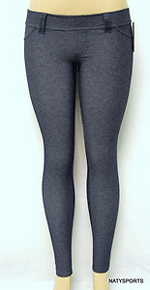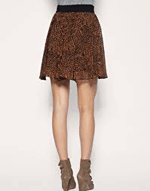Who rocks it best?
IF YOU look in a man’s closet, you’ll probably notice he has a host of blue jeans and maybe a couple pairs of dress pants; and if he’s the outdoorsy type, maybe a sweatpants or two, and some shorts. That’s about it! And he’ll refer to them as simply short pants, long pants or hard pants. Women, on the other hand, have a vast array of pants that, to a man, defies logic. Like most men will get the concept of blue jeans or ladies dress pants, they don’t when it comes to capris, which, to them, are nothing but ill-fitting trousers.
A male writer on one popular comedy website, cracked.com, ponders this point in an interesting article titled, ‘Four things single men will never understand about women’.
He ponders, for instance, whether a pair of capris would still be capris if the shorter of two women with the same size, in terms of body mass, wears one. Are they now  pedal-pushers? Or are they gauchos?
pedal-pushers? Or are they gauchos?
Though having worn many of these fashion choices myself, I had never before given them much thought… Until now!
Capris
Capri pants, also known as three-quarter shorts, clam diggers, or simply Capris, date back to 1948 when they were introduced by European fashion designer, Sonja de Lennart. The pants’ name derives from the Italian isle of Capri, where they rose to popularity in the late 1950s and early 1960s.
The Capris’ acceptance in the United States was influenced by the 1960s television series, “The Dick Van Dyke Show”, wherein a popular female star on the show created a fashion sensation and some mild controversy by wearing snug-fitting Capri pants during the show’s run. The trend spread worldwide. After a drop in popularity during the 1970s through the 1990s, Capris returned to favour during the 2000s.
Pedal pushers
Pedal pushers are calf-length trousers that also peaked in popularity during the 1950s, and then saw resurgence in the 2000s. Often cuffed and worn tight to the skin, they are related in style to Capri pants. The name “pedal pushers” originated from the style originally worn by cyclists.
The pants were instantly embraced by movie stars like Audrey Hepburn. Unlike the Capri pants, which are a slim fit, or tight fitting style that ends just below the knees, pedal pushers could have a looser fit and end at mid-calf. They frequently lacked the characteristic slit on the bottom side seam of the Capri, and might instead feature cuffs.
The goal of pedal pushers was to provide comfortable riding for women without entangling clothing in bicycle chains or wheels. Generally, the longer and looser the pants, the more likely you were to get it snagged in the chain, which could result in their being ripped or, at the very least, grease stained that were hard to remove. Some bicyclists used elastic bands to keep the pants leg away from the chain, and some still do. Pedal pushers offered a way to avoid this unfashionable look and keep the clothing protected.
Sometimes the term pedal pushers are used interchangeably with Capri pants and a variety of other styles of pants that end at the calf or just below the knee. Probably we are mostly familiar, in addition to the terms Capri and pedal pushers, with clam diggers. These cuffed pants were meant to imitate the way people rolled up their pants when searching for clams in ankle deep water.
Leggings/jeggins
Leggings are extremely close-fitting leg coverings made of clingy material. They look like long tights or stockings with the feet portions cut off. Due to their revealing nature, there has been some debate about whether they qualify as pants.
To avoid looking “trashy,” one debater recommends that ladies should keep their goods covered. “I think leggings look okay if a girl wears a long shirt or sweater,” she said. “If they wear a short shirt, it just looks bad.”
Jeggins are a cross between jeans and leggings. They feature a leggings fit and feel, with the more denim and rough-textured look of jeans.
Gauchos By the middle of the 1970s, the former Capri was making a comeback as gaucho pants. While still hitting just below the knee, the new improved gaucho look has a slightly longer in-seam and a slightly flared leg that gave the garment an updated look, compared to the form fitting models of the decade before. Instead of being worn with simple sneakers, the new gaucho pants were more properly worn with knee-high boots. Another change was that the gaucho pants were flared enough to make it into the business world. When coupled with a matching jacket, gaucho pants were soon considered to be acceptable attire for the office, as well as for a date or doing some shopping. Interestingly enough, the gaucho pants of the Seventies were not considered to be casual attire at all, but more of a nice compromise between formal and informal dress.
By the middle of the 1970s, the former Capri was making a comeback as gaucho pants. While still hitting just below the knee, the new improved gaucho look has a slightly longer in-seam and a slightly flared leg that gave the garment an updated look, compared to the form fitting models of the decade before. Instead of being worn with simple sneakers, the new gaucho pants were more properly worn with knee-high boots. Another change was that the gaucho pants were flared enough to make it into the business world. When coupled with a matching jacket, gaucho pants were soon considered to be acceptable attire for the office, as well as for a date or doing some shopping. Interestingly enough, the gaucho pants of the Seventies were not considered to be casual attire at all, but more of a nice compromise between formal and informal dress.
Shorts
Shorts can be dressy or casual, chic or frumpy, and can come in many varieties. From super-short Daisy Dukes to above-the-knee Bermudas, there are plenty of shorts options for women, if they are looking to avoid skirts and stay cool on a hot day. One major advantage is that bolder colours and patterns are more appropriate for shorts, than they are for full-length pants, as the pattern or colour won’t look overwhelming with less material.
Bermudas are knee-length shorts, and often have a slimmer profile. They usually have square pockets on the side as well.
Cut-offs, on the other hand, are denim shorts that are roughly cut off from full-length jeans at some point along the leg, often high on the thigh. The wearer usually does the alteration herself.
Cargo pants, meanwhile, are shorts that have large side pockets; they can either be quite loose or more form-fitting, and they vary in length widely. The closures for the pockets vary widely from Velcro, to snaps, to zippers.
The Culotte
Culottes, also known as “skorts”, are shorts covered with a piece of fabric so that they mimic the appearance of skirts. Some have the skirt panel in the front only. Others go all the way around the shorts.
Hot Pants ‘n Bun Huggers
Hot pants, also called short shorts and Daisy Dukes after the television character’s signature super-short pants, are shorts with very small inseams that are worn very tight against the buttocks and thighs. Some styles are so short as to reveal the bottom of the buttocks. Bun huggers are similar shorts, but are more for athletics than for casual wear. Professional volleyball, for example, requires women athletes to wear bun huggers.



.jpg)









